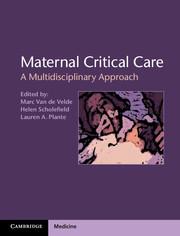Book contents
- Maternal Critical Care
- Maternal Critical Care
- Copyright page
- Dedication
- Contents
- Contributors
- Preface
- Section 1 General non-medical considerations
- Section 2 General medical considerations
- Section 3 Special critical care tools and techniques
- Chapter 17 Airway management
- Chapter 18 Mechanical ventilation
- Chapter 19 Sedation and pain management
- Chapter 20 Nutrition
- Chapter 21 Monitoring the critically ill gravida
- Chapter 22 Imaging issues in maternal critical care
- Section 4 The pregnant patient with coexisting disease
- Section 5 Serious problems related to pregnancy
- Index
Chapter 22 - Imaging issues in maternal critical care
from Section 3 - Special critical care tools and techniques
Published online by Cambridge University Press: 05 July 2013
- Maternal Critical Care
- Maternal Critical Care
- Copyright page
- Dedication
- Contents
- Contributors
- Preface
- Section 1 General non-medical considerations
- Section 2 General medical considerations
- Section 3 Special critical care tools and techniques
- Chapter 17 Airway management
- Chapter 18 Mechanical ventilation
- Chapter 19 Sedation and pain management
- Chapter 20 Nutrition
- Chapter 21 Monitoring the critically ill gravida
- Chapter 22 Imaging issues in maternal critical care
- Section 4 The pregnant patient with coexisting disease
- Section 5 Serious problems related to pregnancy
- Index
Summary
Keywords
- Type
- Chapter
- Information
- Maternal Critical CareA Multidisciplinary Approach, pp. 230 - 246Publisher: Cambridge University PressPrint publication year: 2013



